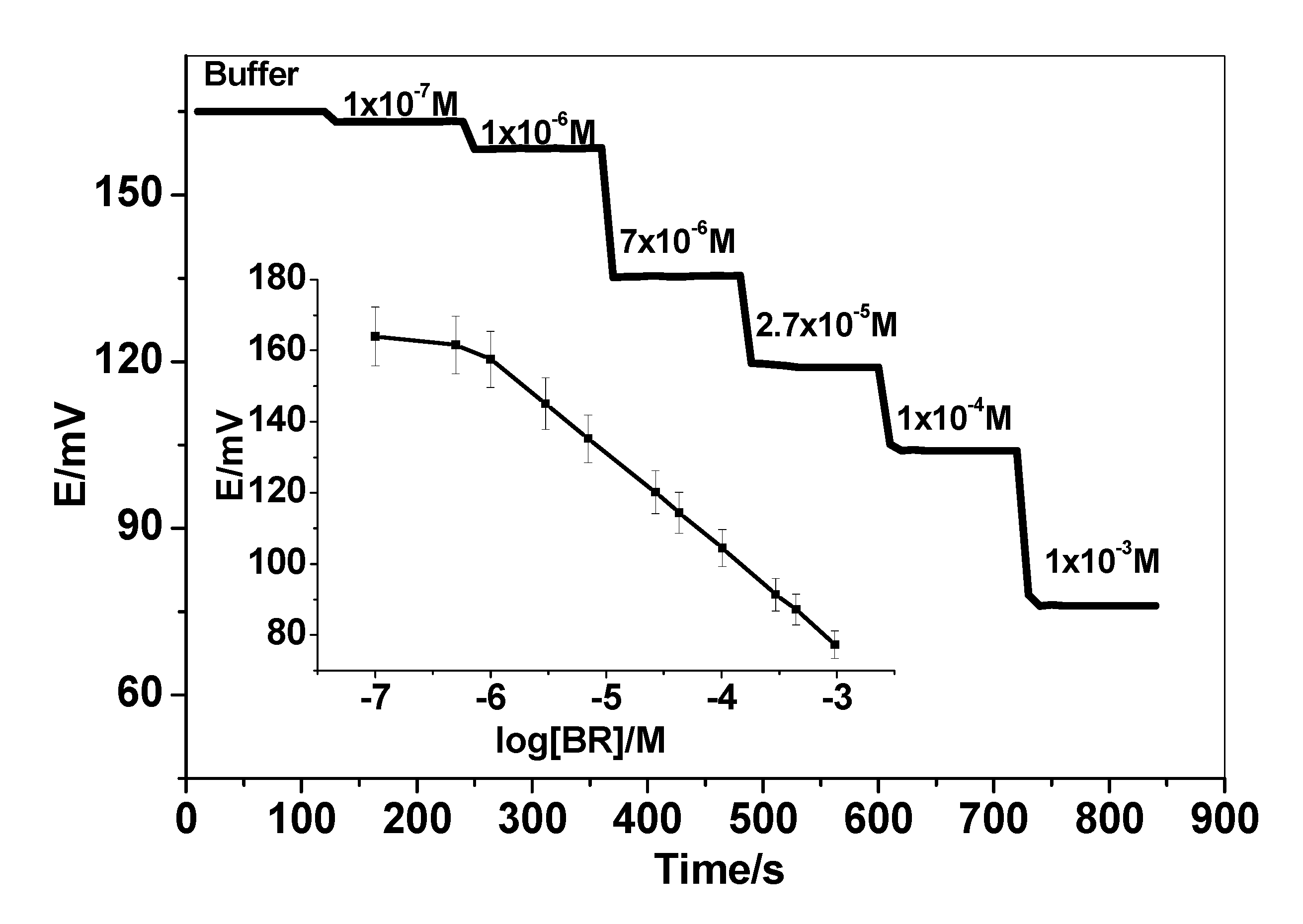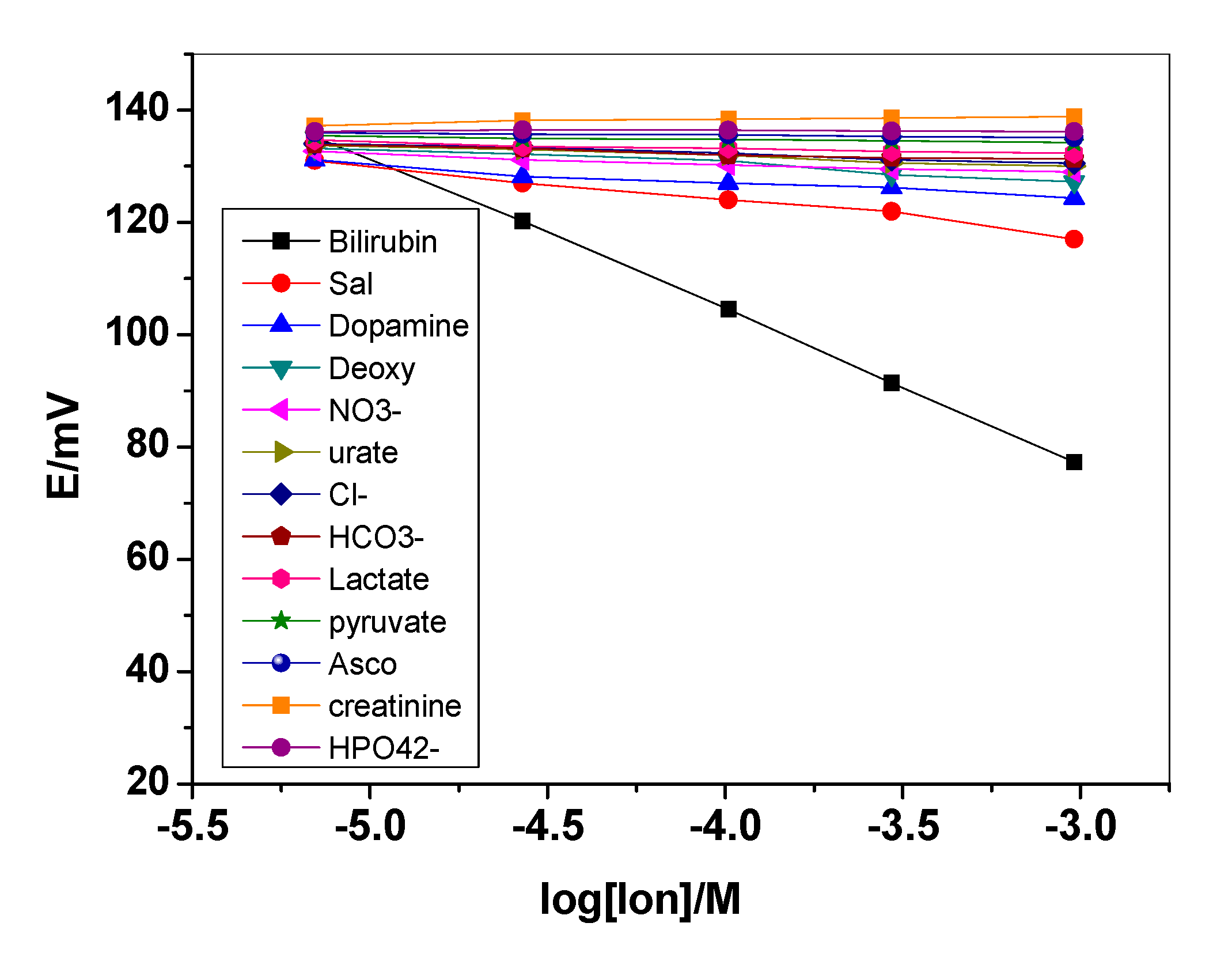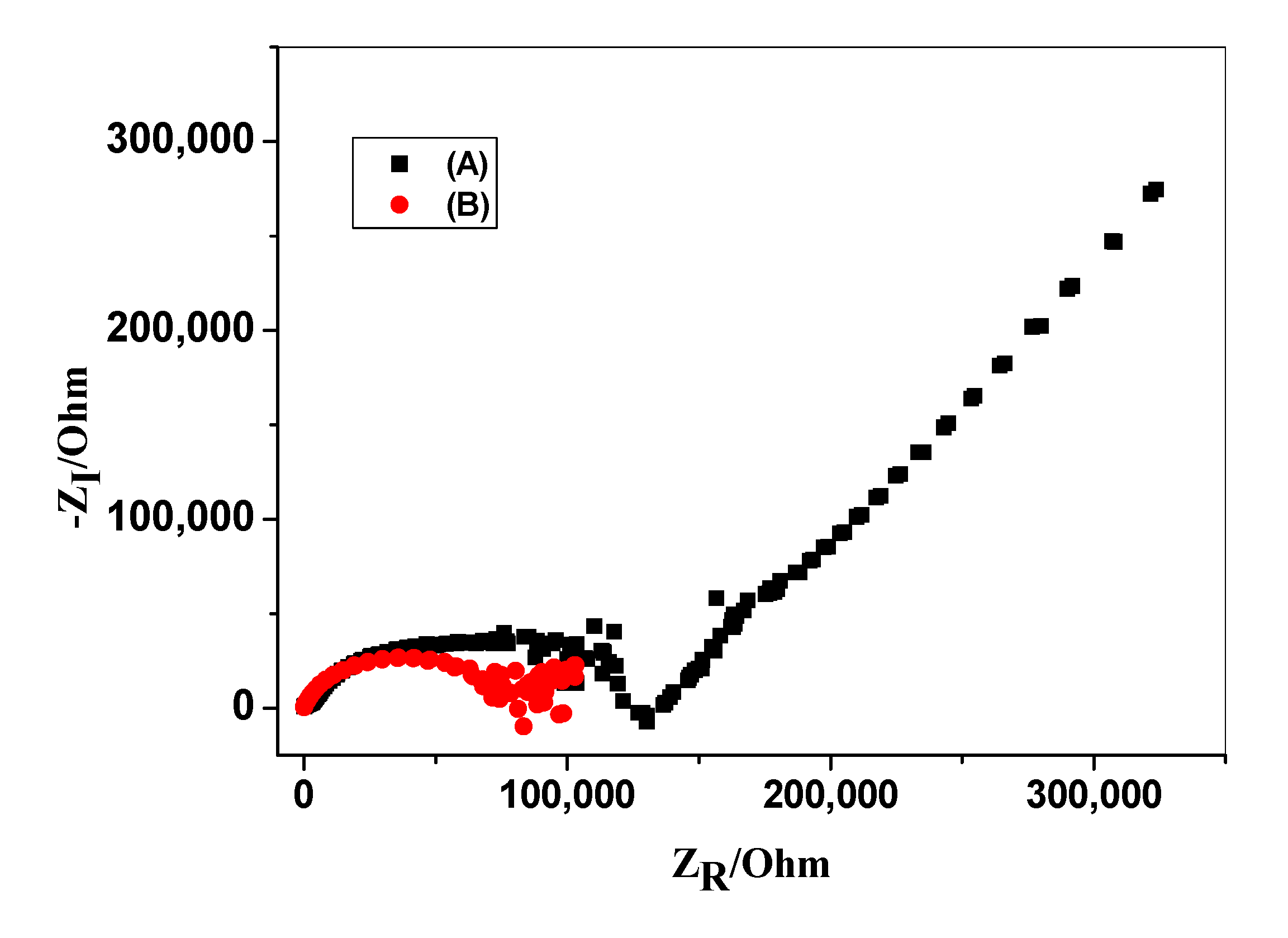Screen-Printed Sensor Based on Potentiometric Transduction for Free Bilirubin Detection as a Biomarker for Hyperbilirubinemia Diagnosis
Abstract
1. Introduction
2. Materials and Methods
2.1. Chemicals and Instrumentation
2.2. Sensors Constructions
2.3. Determination of Free BR in Presence of Albumin
2.4. Determination of Human Serum Albumin (HSA)
3. Results and Discussions
3.1. Response Characteristics of BR Sensor
3.2. Data Repeatability and Reproducibility
3.3. Sensors’ Selectivity
3.4. Chronopotentiometry and Electrochemical Impedance Spectroscopy (EIS) Measurements
3.5. Bilirubin Assessment in Serum
3.6. Application to Human Serum Albumin (HSA) Determination
4. Conclusions
Author Contributions
Funding
Conflicts of Interest
References
- Tiribelli, C.; Ostrow, J.D. The molecular basis of bilirubin encephalopathy and toxicity: Report of an EASL Single Topic Conference. J. Hepatol. 2005, 43, 156–166. [Google Scholar] [CrossRef] [PubMed]
- Zunszain, P.A.; Ghuman, J.; McDonagh, A.F.; Curry, S. Crystallographic analysis of human serum albumin complexed with 4Z,15E-bilirubin-IXalpha. J. Mol. Biol. 2008, 381, 394–406. [Google Scholar] [CrossRef] [PubMed]
- Vitek, L.; Ostrow, J.D. Bilirubin chemistry and metabolism; harmful and protective aspects. Curr. Pharm. Des. 2009, 15, 2869–2883. [Google Scholar] [CrossRef] [PubMed]
- Erlinger, S.; Arias, I.M.; Dhumeaux, D. Inherited disorders of bilirubin transport and conjugation: New insights into molecular mechanisms and consequences. Gastroenterology 2014, 146, 1625–1638. [Google Scholar] [CrossRef]
- Jacobsen, J.; Wennberg, R.P. Determination of unbound bilirubin in the serum of newborns. Clin.Chem. 1974, 20, 783–789. [Google Scholar] [CrossRef]
- American Academy of Pediatrics Subcommittee on Hyperbilirubinemia. Management of hyperbilirubinemia in the new borninfant 35 or more weeks of gestation. Pediatrics 2004, 114, 297. [Google Scholar] [CrossRef]
- Balamurugan, T.; Berchmans, S. Non-enzymatic detection of bilirubin based on agraphene-polystyrene sulfonate composite. RSC Adv. 2015, 5, 50470–50477. [Google Scholar] [CrossRef]
- Ahlfors, C.E.; Wennberg, R.P.; Ostrow, J.D.; Tiribelli, C. Unbound (free) bilirubin: Improving the paradigm for evaluating neonatal jaundice. Clin. Chem. 2009, 55, 1288–1299. [Google Scholar] [CrossRef]
- Santhosh, M.; Chinnadayyala, S.R.; Kakoti, A.; Goswami, P. Selective and sensitive detection of free bilirubin in blood serum using human serum albumin stabilized gold nanoclusters as fluorometric and colorimetric probe. Biosens. Bioelectron. 2014, 59, 370–376. [Google Scholar] [CrossRef]
- Joseph, W.; Mebmet, O. A polishableamperometric biosensor for bilirubin. Electroanalysis 1990, 2, 647–650. [Google Scholar]
- Doumas, B.T.; Perry, B.; Jendrzejczak, B.; Davis, L. Measurement of Direct bilirubin by use of bilirubin oxidase. Clin. Chem. 1987, 33, 1349–1353. [Google Scholar] [CrossRef] [PubMed]
- Shoham, B.; Migron, Y.; Riklin, A.; Willner, I.; Tartakovsky, B. A bilirubin biosensor based on a multilayer network enzyme electrode. Biosens. Bioelectron. 1995, 10, 341–352. [Google Scholar] [CrossRef]
- Lu, C.; Lin, J.M.; Huie, C.W. Determination of total bilirubin in human serum by chemiluminescence from the reaction of bilirubin and peroxynitrite. Talanta 2004, 63, 333–337. [Google Scholar] [CrossRef] [PubMed]
- Ma, G.; Lin, J.; Cai, W.; Tan, B.; Xiang, X.; Zhang, Y.; Zhang, P. Simultaneous determination of bilirubin and its glucuronides in liver microsomes and recombinant UGT1A1 enzyme incubation systems by HPLC method and its application to bilirubin glucuronidation studies. J. Pharm. Biomed. Anal. 2014, 92, 149–159. [Google Scholar] [CrossRef] [PubMed]
- Yang, Z.; Yan, J.; Zhang, C. Piezoelectric detection of bilirubin based on bilirubin imprinted titaniafilm electrode. Anal. Biochem. 2012, 421, 37–42. [Google Scholar] [CrossRef]
- Nie, Z.; Fung, Y.S. Microchip capillary electrophoresis for frontal analysis of free bilirubin and study of its interaction with human serum albumin. Electrophoresis 2008, 29, 1924–1931. [Google Scholar] [CrossRef]
- Rand, R.N.; Pasqua, A.D. A new diazo method for the determination of bilirubin. Clin. Chem. 1962, 8, 570–578. [Google Scholar] [CrossRef]
- Chen, J.; Song, G.; Yu He, Y.; Yan, Q. Spectroscopic analysis of the interaction between bilirubin and bovine serum albumin. Microchim. Acta 2007, 159, 79–85. [Google Scholar] [CrossRef]
- Ho, H.T.; Ng, T.K.; Tsui, K.C.; Lo, Y.C. Evaluation of a new transcutaneous bilirubinometer in Chinese newborns. Arch. Dis. Child. Fetal Neonatal Ed. 2006, 91, F434–F438. [Google Scholar] [CrossRef]
- Tan, K.L.; Dong, F. Transcutaneous bilirubinometry during and after phototherapy. Acta Paediatr. 2003, 92, 327–331. [Google Scholar] [CrossRef]
- Kamel, A.H.; Hassan, A.M.E. Solid Contact Potentiometric Sensors Based on Host-Tailored MolecularlyImprinted Polymers for Creatine Assessment. Int. J. Electrochem. Sci. 2016, 11, 8938–8949. [Google Scholar] [CrossRef]
- El-Naby, E.H.; Kamel, A.H. Potential transducers based man-tailored biomimetic sensors for selective recognition of dextromethorphan as an antitussive drug. Mater. Sci. Eng. C 2015, 54, 217–224. [Google Scholar] [CrossRef] [PubMed]
- El-Kosasy, A.; Kamel, A.H.; Hussin, L.; Ayad, M.F.; Fares, N. Mimicking new receptors based on molecular imprinting and their application to potentiometric assessment of 2, 4-dichlorophenol as a food Taint. Food Chem. 2018, 250, 188–196. [Google Scholar] [CrossRef] [PubMed]
- Kamel, A.H.; Jiang, X.; Li, P.; Liang, R. A paper-based potentiometric sensing platform based on molecularly imprinted nanobeads for determination of bisphenol A. Anal. Meth. 2018, 10, 3890–3895. [Google Scholar] [CrossRef]
- Kamel, A.H.; Soror, T.Y.; Al-Romian, F.M. Graphite Solid-Contact Mepiquat Potentiometric Sensors Based on Molecularly Imprinted Polymers and Their Application to Flow Through Analysis. Anal. Meth. 2012, 4, 3007–3012. [Google Scholar] [CrossRef]
- Hassan, S.S.M.; Badr, I.H.A.; Kamel, A.H.; Mohamed, M.S. A Novel Poly (Vinyl Chloride) Matrix Membrane Sensor for Batch and Flow-injection Determination of Thiocyanate, Cyanide and Some Metal Ions. Anal. Sci. 2009, 25, 911–917. [Google Scholar] [CrossRef]
- Hassan, S.S.M.; Amr, A.E.; Elbehery, N.H.A.; Al-Omar, M.A.; Kamel, A.H. Non-equilibrium potential responses towards neutral orcinol using all-solid-state potentiometric sensors integrated with molecularly imprinted polymers. Polymers 2019, 11, 1232. [Google Scholar] [CrossRef]
- Kamel, A.H.; Amr, A.E.; Ashmawy, N.H.; Galal, H.R.; Al-Omar, M.A.; Sayed, A.Y.A. Solid-Contact Potentiometric Sensors Based on Stimulus-Responsive Imprinted Polymers for Reversible Detection of Neutral Dopamine. Polymers 2020, 12, 1406. [Google Scholar] [CrossRef] [PubMed]
- Zuliani, C.; Diamond, D. Opportunities and challenges of using ion-selective electrodes in environmental monitoring and wearable sensors. Electrochim. Acta 2012, 84, 29–34. [Google Scholar] [CrossRef]
- Li, Y.; Chen, Y.; Yu, H.; Tian, L.; Wang, Z. Portable and smart devices for monitoring heavy metal ions integrated with nanomaterials. TrAC Trends Anal. Chem. 2018, 98, 190–200. [Google Scholar] [CrossRef]
- Janata, J. Potentiometric microsensors. Chem. Rev. 1990, 90, 691–703. [Google Scholar] [CrossRef]
- Yan, R.; Qiu, S.; Tong, L.; Qian, Y. Review of progresses on clinical applications of ion selective electrodes for electrolytic ion tests: From conventional ISEs to graphene-based ISEs. Chem. Speciat. Bioavailab. 2016, 28, 72–77. [Google Scholar] [CrossRef]
- Bell, J.G.; Mousavi, M.P.S.; Abd El-Rahman, M.K.; Tan, E.K.W.; Homer-Vanniasinkam, S.; Whitesides, G.M. Paper-based potentiometric sensing of free bilirubin in blood serum. Biosens. Bioelectron. 2019, 126, 115–121. [Google Scholar] [CrossRef] [PubMed]
- Hassan, S.S.M.; Sayour, H.E.M.; Kamel, A.H. A simple-potentiometric method for determination of acid and alkaline phosphatase enzymes in biological fluids and dairy products using a nitrophenylphosphate plastic membrane sensor. Anal. Chim. Acta 2009, 640, 75–81. [Google Scholar] [CrossRef]
- Kamel, A.H.; Sayour, H.E.M. Flow-Through Assay of Quinine Using Solid Contact Potentiometric Sensors Based on Molecularly Imprinted Polymers. Electroanalysis 2009, 21, 2701–2708. [Google Scholar] [CrossRef]
- Jacobsen, J.; Brodersen, R. Albumin-bilirubin binding mechanism—Kinetic and spectroscopic studies of binding of bilirubin and Xanthobilirubic acid to human serum albumin. J. Biol. Chem. 1983, 258, 6319–6326. [Google Scholar]
- Guerreiro, J.R.L.; Kamel, A.H.; Sales, M.G.F. FIA potentiometric system based on periodate polymeric membrane sensors for the assessment of ascorbic acid in commercial drinks. Food Chem. 2010, 120, 934–939. [Google Scholar] [CrossRef][Green Version]
- Hahm, J.S.; Ostrow, J.D.; Mukerjee, P.; Celic, L. Ionization and self-association of unconjugated bilirubin, determined by rapid solvent partition from chloroform, with further-studies of bilirubin solubility. J. Lipid Res. 1992, 33, 1123–1137. [Google Scholar]
- Silbernagl, S.; Despopoulos, A. Color Atlas of Physiology, 6th ed.; Thieme: Stuttgart, Germany; New York, NY, USA, 2009; Volume 459, pp. 520–521. [Google Scholar]
- Bakker, E.; Pretsch, E.; Buhlmann, P. Selectivity of Potentiometric Ion Sensors. Anal. Chem. 2000, 72, 1127–1133. [Google Scholar] [CrossRef]
- Lopez, J.; Burtis, C.A.; Ashwood, E.R.; Bruns, D.E. Tietz textbook of clinical chemistry and molecular diagnosis (5th edition). Indian J. Clin. Biochem. 2013, 28, 104–105. [Google Scholar] [CrossRef]
- Levine, M.; Rumsey, S.C.; Daruwala, R.; Park, J.B.; Wang, Y.H. Criteria and recommendations for vitamin C intake. JAMA J. Am. Med. Assoc. 1999, 281, 1415–1423. [Google Scholar] [CrossRef] [PubMed]
- Krishnamurthy, K.; Wang, G.H.; Rokhfeld, D.; Bieberich, E. Deoxycholate promotes survival of breast cancer cells by reducing the level of pro-apoptotic ceramide. Breast Cancer Res. 2008, 10, 1–16. [Google Scholar] [CrossRef] [PubMed]
- Nakamura, H.; Murakami, Y.; Yokoyama, K.; Tamiya, E.; Karube, I. A compactly integrated flow cell with a chemiluminescent FIA system for determining lactate concentration in serum. Anal. Chem. 2001, 73, 373–378. [Google Scholar] [CrossRef] [PubMed]
- Mascini, M.; Mazzei, F. Amperometric sensor for pyruvate with immobilized pyruvate oxidase. Anal. Chim. Acta 1987, 192, 9–16. [Google Scholar] [CrossRef]
- Hassan, S.M.M.; Elnemma, E.M.; Ayman, H.K.; Mohamed, A.H.K. Novel Biomedical Sensors for Flow Injection Potentiometric Determination of Creatinine in Human Serum. Electroanalysis 2005, 17, 2246–2253. [Google Scholar] [CrossRef]
- Zhao, J.; Huang, Y. Salivary uric acid as a noninvasive biomarker for monitoring the efficacy of urate-lowering therapy in a patient with chronic gouty arthropathy. Clin. Chim. Acta 2015, 450, 115–120. [Google Scholar] [CrossRef]
- Bobacka, J. Potential stability of all-solid-state ion-selective electrodes using conducting polymers as ionto-electron transducers. Anal. Chem. 1999, 71, 4932–4937. [Google Scholar] [CrossRef]






| Interfering Ion | *logPotKBR,I | logPotKBR,I, [33] | Physiological Levels in Serum |
|---|---|---|---|
| Cl− | −5.32 ± 0.3 | −6.11 | 98–106 mM, [41] |
| HPO42− | −6.65 ± 0.7 | −5.46 | 0.4–0.7 mM, [41] |
| NO3− | −4.50 ± 0.2 | −4.40 | 8–68 μM, [41] |
| HCO3− | −5.71 ± 0.7 | −6.25 | 17–29 mM, [41] |
| Salicylate | −2.12 ± 0.4 | −2.92 | NR |
| Ascorbate | −6.51 ± 0.6 | −7.90 | 36–79 μM, [42] |
| Deoxycholate | −4.4 ± 0.2 | −4.33 | 5–10 μM, [43] |
| Lactate | −5.91 ± 0.1 | −6.47 | 0.5–1.8 mM, [44] |
| Pyruvate | −6.31 ± 0.4 | −6.50 | 40–120 μM, [45] |
| Creatinine | −6.61 ± 0.7 | - | 35–140 μM, [46] |
| Dopamine | −4.32 ± 0.8 | - | - |
| Urate | −4.98 ± 0.9 | - | 200–430 μM, [47] |
| Sample | Nominal Content of BR, µM+ 80 µM of Albumin | Free BR Found, µM | t-Student Test b | F-Test b | |
|---|---|---|---|---|---|
| Proposed Method * | Reference Spectrophotometric Method * | ||||
| 1 | 100 | 17.4 ± 1.3 | 18.2 ± 1.1 | 2.3 | 4.6 |
| 2 | 150 | 62.7 ± 2.2 | 64.2 ± 1.5 | 3.1 | 5.2 |
| 3 | 200 | 119 ± 3.5 | 115.7 ± 1.4 | 1.8 | 6.1 |
| 4 | 500 | 362.6 ± 4.1 | 365.3 ± 2.1 | 2.1 | 5.3 |
© 2020 by the authors. Licensee MDPI, Basel, Switzerland. This article is an open access article distributed under the terms and conditions of the Creative Commons Attribution (CC BY) license (http://creativecommons.org/licenses/by/4.0/).
Share and Cite
H. Kamel, A.; Amr, A.E.-G.E.; Galal, H.R.; Al-Omar, M.A.; Almehizia, A.A. Screen-Printed Sensor Based on Potentiometric Transduction for Free Bilirubin Detection as a Biomarker for Hyperbilirubinemia Diagnosis. Chemosensors 2020, 8, 86. https://doi.org/10.3390/chemosensors8030086
H. Kamel A, Amr AE-GE, Galal HR, Al-Omar MA, Almehizia AA. Screen-Printed Sensor Based on Potentiometric Transduction for Free Bilirubin Detection as a Biomarker for Hyperbilirubinemia Diagnosis. Chemosensors. 2020; 8(3):86. https://doi.org/10.3390/chemosensors8030086
Chicago/Turabian StyleH. Kamel, Ayman, Abd El-Galil E. Amr, Hoda R. Galal, Mohamed A. Al-Omar, and Abdulrahman A. Almehizia. 2020. "Screen-Printed Sensor Based on Potentiometric Transduction for Free Bilirubin Detection as a Biomarker for Hyperbilirubinemia Diagnosis" Chemosensors 8, no. 3: 86. https://doi.org/10.3390/chemosensors8030086
APA StyleH. Kamel, A., Amr, A. E.-G. E., Galal, H. R., Al-Omar, M. A., & Almehizia, A. A. (2020). Screen-Printed Sensor Based on Potentiometric Transduction for Free Bilirubin Detection as a Biomarker for Hyperbilirubinemia Diagnosis. Chemosensors, 8(3), 86. https://doi.org/10.3390/chemosensors8030086








